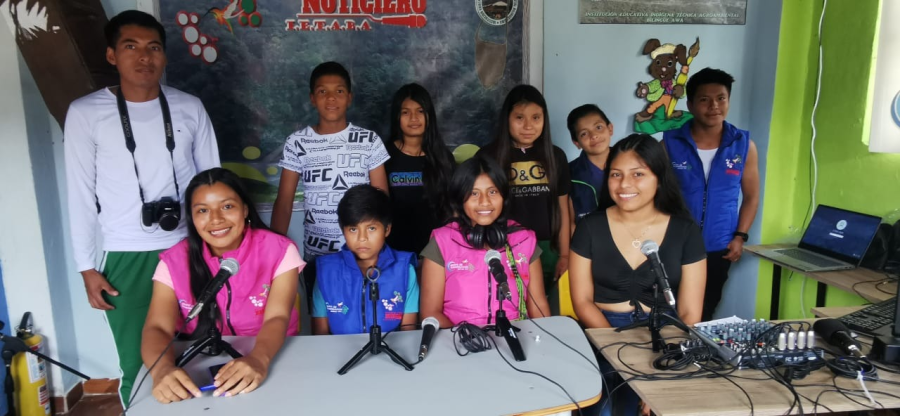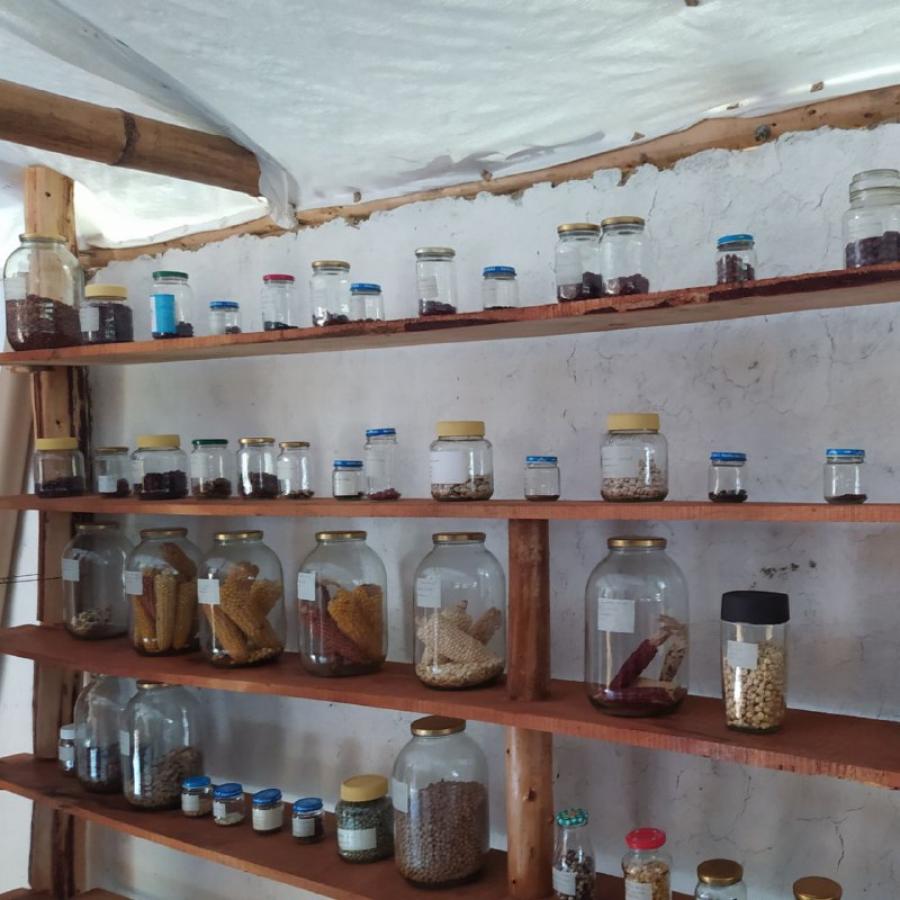Along process of extermination and reduction of rich and advanced Indian cultures began almost 500 years ago. The Aztec, Maya, Tayrona, Inca and Muisca, among others, had large cities and a wide variety of crops; they Were accomplished artisans, musicians and singers, philosophers and mathematicians, recognized astronomers and scientists. But, the conquest violently altered the dynamics of indigenous America; with it came land seizures, tribute payments and various forms of labor control such as the repartimiento, the encomienda and the mita. Onto Indian society, the colono imposed not only himself but his language, beliefs, customs and personal interests.
Nowadays in Colombia's multi-ethnic society more than 75 separate Indian cultures (about 2% of the total population) resist the continual besiegement and aggression of the national majority. Those who have survived the difficult and persistent struggle possess valuable and extensive territories, lands which are sacred to them and essential for their physical survival. In most cases, their rights to these lands are not recognized; even when they are the lands have been repeatedly invaded with little opposition from the authorities.
According to the Colombian National Planning Board, "...only about 1/2 of the nation's Indians possess lands legally titled by the State..." Even these, however, including those who have resguardos (communal landholdings) with title (36% of the total Indian population) and those who have been granted zonas de reserva (9% of the indigenous population), face critical problems of invasion and dispossession of their lands by colonists.
The formal education directly provided by the State or contracted through the Missions usually reveals: "...a system inadequate to meet the specific characteristics and needs of the different Indian groups...". This educational system also exhibits ethnocentric, sometimes racist, criteria. Far from helping to strengthen the Indians' cultural identity, helping to train them and to seek alternative solutions for their different needs and problems, education has contributed to the gradual destruction of their values and of their cultures in general, making Indians ashamed of themselves.
In the field of health, even a superficial sampling of the illness and mortality rates illustrates the Indians' precarious living conditions. Nutrition levels decrease as Indians are deprived of their lands for subsistence agriculture.
Colombian government policy has oscillated between demagoguery, paternalism and repression. Law 89 of 1890 is still in force. Although this law "determines the manner in which the savages should be governed, with the goal of making them civilized" and should be changed to meet present realities, it is much more "progressive" and in keeping with the interests of the Indians, in terms of protection of their resguardos and in respecting their local authorities (cabildos), than the so-called Indian Statute proposed by the Colombian government in 1980. This statute not only denied, in an indirect way, the Indians' rights of ownership of traditionally occupied lands, it also conferred on the President of the Republic absolute authority over the Indians' legal system and social organization. This statute never became law, due to strong opposition by Indian organizations, some international human rights groups and organizations of professionals such as anthropologists and lawyers.
The Formation of ONIC
Not everything happening to indigenous societies is negative. At present, many are joining into a unified movement with a presence in the national socioeconomic and political life. In Bogotá in February 1982, the indigenous communities of Colombia held their "1st National Indian Congress," from which the National Indian Organization of Colombia (ONIC) emerged, an historic event in the development of the Colombian Indians' struggle to defend their rights. ONIC is the result of a long and difficult struggle undertaken by workers such as Manuel Quintín Lame, Eutiquio Timote, Gonzalo Sánchez, Gustavo Mejía and Benjamín Dindicué.
As early as 1920 a tenant farmer on his own lands in the Department of Cauca and Tolima, Manuel Quintín Lame came forth to demand respect for indigenous culture and to reclaim the lands of the resguardos taken over by large landowners. In 1971, reflecting both the development of the campesino movement's fight for land and a cultural need felt by the Paéz and Guambiano Indian communities, the Regional Indian Council of Cauca (CRIC) came into being. CRIC, as an organization which represents the resguardos and cabildos of the Department of Cauca, has been recovering and extending, often by means of invasions, lands that had been taken from them. Also, by establishing communal farms and enterprises on them they helped to organize and strengthen the Indian cabildos, the traditional authorities of the resguardos. CRIC also fights to eliminate the practice of terraje (rent paid on arable land), a feudal practice in which Indian families must work without pay for the large non-Indian landowners. To defend Indian culture, CRIC has created bilingual schools and has trained school teachers to develop their own curriculum. Concerned about the economic exploitation of Indians, CRIC has organized training courses on legal, political and economic themes, thus helping to raise the Indians' awareness of their situation.
Confronted with the growth and success of CRIC, the large landowners, and in many cases political and military authorities as well, have unleashed a campaign of violent repression. CRIC's struggles have resulted in successes but also in suffering. In 1973, Gustavo Mejía, one of its founders, was assassinated, and several years later Benjamín Dindicué, the vice-president of the organizations, was also murdered. Up to the present time, more than 100 Indians have been assassinated, all of them occupying leadership positions in CRIC such as cabildo officials or managers of communal businesses or cooperatives. Other Indians have been imprisoned or had their resguardos occupied by military forces; some have been taken before the military tribunals and others have been tortured.
CRIC, however, is becoming stronger, and its message reaches other Colombian Indian communities also in the process of organizing. In October 1980, during the regional meeting organized by the Regional Indian Council of Tolima (CRIT), a National Coordinating Commission was created, composed of delegates from the Indian communities of Arhuaco, Paéz, Guambiano, Pijao and Emberá, among others. The main task of the Coordinating Commission was to organize the first National Congress in 1982, ten years after the Paéz and Guambiano Indians in Cauca had begun the process of organizing Indians in Colombia. Since then, the Colombian Indian movement has become progressively stronger. It now includes 16 organizations or Regional Councils from various areas of the country. These organizations and councils, overcoming numerous economic, political or geographical obstacles, called the "First National Indian Congress." It was attended by the Regional Indian Council of Cauca (CRIC), the Regional Indian Council of Tolima (CRIT), the Regional Organization of Emberá Indians (BREWA), an organization of Sikuane Indians of the LLanos Orientales (UNUMA), the Union of Indians of Acaricuana (UNKAC), the Regional Indian Council of Western Colombia (CRIDOC), Regional Indian Council of Vaupés (CRIVA), the Indian Cabildos of San Andrés de Satavento, the Union of Cubeo Indians (UDIC), the Regional Indian Organization of Orteguaza Medio (ORIOM), the Tayrona Confederation of Sierra Nevada de Santa Marta, the Indian Organization of Antioquia (OICA), the Union of Indians of the Papurí (UNIP), the Regional Indian Council of Guainiá (CRIGUA) and the Union of Indians of Chocó (UNDICH).
In the first congress the Indians, united around the slogan "Por la unidad, la cultura y la autonomia" ("For unity, land, culture, and autonomy"), created ONIC, the Colombian National Indian Organization. During the initial period they hope to accomplish the following:
1. Defend Indian autonomy;
2. Defend Indian territories, recuperation of usurped lands, collective ownership of the resguardos;
3. Gain control of the natural resources located within Indian territories;
4. Promote communal economic organizations;
5. Defend Indian history, culture and traditions;
6. Create bilingual and bicultural education, under the control of Indian authorities;
7. Revitalize and promote indigenous medicine and demand for health programs consistent with the social and cultural characteristics of the communities;
8. Demand the (enforcement) of Law 89 of 1890 and other legal decrees favorable to Indians;
9. Express solidarity with the struggle of all exploited and oppressed peoples.
The Indian organization bases its struggle on the need to contribute to the construction of a new Colombian society. In one of the documents presented for discussion in the First Indian Congress, the following was put forth:
It is necessary to see the Indian problem in our country in relation to the expansion of capitalism in the countryside, connected to the increasingly active role of the State and its presence as much from economic and political points of view as from cultural ones. The dominant classes in this system, as well as their government, exercise a political and economic domination which create the conditions for opening up and adjusting of the Indian communities to the expanding capitalist economy. It is in this context that Indian struggle for the defense and conservation of the land and for their culture and organization is played out.
The Indians, now organized, demand a hearing. They have identified the guidelines on which they feel that Colombian Indian policy should be based. It should not be, they believe, an "integrationist" policy which seeks to "incorporate Indians into national life," denying them the possibility of being Indian, allowing instead the expropriation (and dissolution) of their lands and thus leading to their physical and cultural disappearance. Nor should it be an isolationist and utopian "indigenist" policy, creating "human zoos" isolated from the social and historical events of the country. These two alternatives are equally destructive.
Instead, the Indian people insist on the return of their lands. They demand respect for their traditions and customs, for their language and culture in general. They demand respect for their right to autonomy - understood as the right to interpret (and write) their own history - to educate themselves and develop their potential without losing their identity. They thus seek inclusion into Colombian social, economic and political life, of which they are historically a part.
Article copyright Cultural Survival, Inc.



